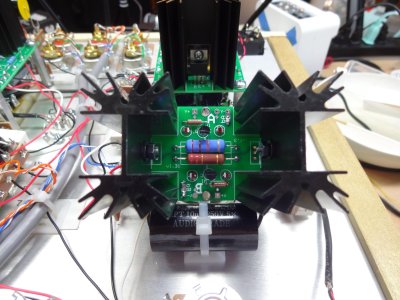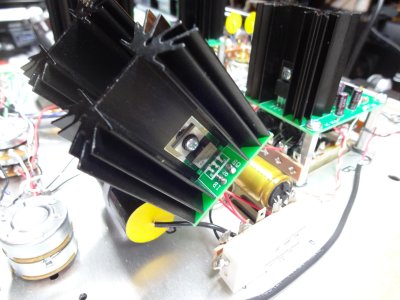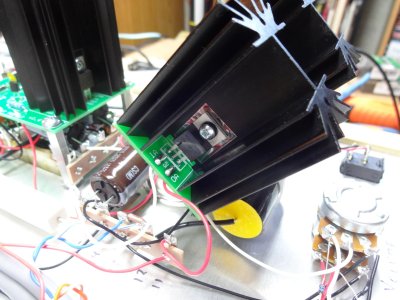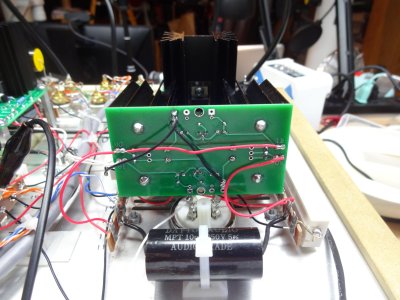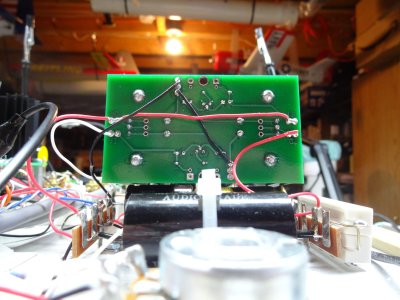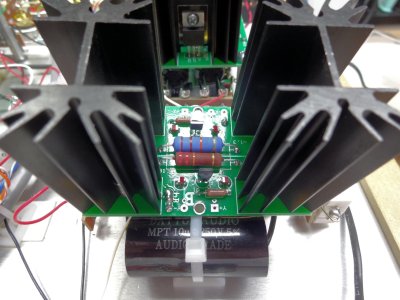You can try swapping the high current C4S boards. If the bad voltages follow a board, then we can focus on that. If they stay on that side of the amp, then you know the board is OK at least.
You are using an out of date browser. It may not display this or other websites correctly.
You should upgrade or use an alternative browser.
You should upgrade or use an alternative browser.
No Sound from Right Channel
- Thread starter ScottAstroNut
- Start date
ScottAstroNut
Member
I swapped the C4S boards. An immediate change I noticed was that now all the LED's were lighting up. However, I also noticed that whereas the R channel C4S previously had been cooler than the L, now it was the other way around. The same "cool" board stayed cool.
Checking voltages, the bad voltages migrated with the change in position of the boards. Terminals 2 and 6, which had previously read as 1.7V and 187V, now read 90V and 146V, just as they should. However, now terminal 11 reads 185V and terminal 17 reads 0.1V.
So the problem is with the C4S board?
Checking voltages, the bad voltages migrated with the change in position of the boards. Terminals 2 and 6, which had previously read as 1.7V and 187V, now read 90V and 146V, just as they should. However, now terminal 11 reads 185V and terminal 17 reads 0.1V.
So the problem is with the C4S board?
ScottAstroNut
Member
As a further note, I had previously resoldered the entire "bad" (previously R channel side) C4S board, bur resoldered a couple of connections again anyway. I also double-checked that all the components were in the correct locations and in the correct orientations. I couldn't find a problem. I reconnected and retested the board, but with no change. As far as I can tell it's not a bad solder joint.
ScottAstroNut
Member
I should say, in that last comment, that I reconnected power to the board, not the board itself. I didn't remove and resolder it a second time.
D
Deke609
Guest
ScottAstroNut said:Terminal 1 at close to zero volts (1.7V)
Terminal 6 at 187V
...
ScottAstroNut said:Terminals 2 and 6, which had previously read as 1.7V and 187V, now read 90V and 146V ...
Ah ... so terminal "1" in your earlier post was a typo? That's what prompted the recommendation to check and resolder the filament wiring.
ScottAstroNut
Member
Hi Derek,
Yes, a typo!!! My apologies! I can see how that would have sent you down an entirely different path!!!
You know, I must be getting a bit dull in my "old age." Not only am I making typos, but I am making wiring mistakes, too. This BeePre is my seventh Bottlehead kit, and it's the first one that didn't work right the first time I plugged it in. Usually I am very good at following directions and wiring. In this kit I have found two significant mistakes in my wiring, both simple mistakes that I should have caught if I had been more careful.
I have to say, though, that even though I am having a bit of trouble with this BeePre, overall the Bottlehead kits have been amazing. My undergraduate education is in electrical engineering, but I actually did relatively little with analog circuits and nothing at all with vacuum tubes in my college education. I was mostly into microprocessors and digital logic, so all solid state and mostly IC's. Lots of prototyping with wire-wrapped sockets on perfboards and lots of assembler language programming. Getting to play with tubes has been great fun and very educational. I just wished I had gotten into it years ago.
I really appreciate how helpful the people on these forums are, including yourself! It's a great community.
Yes, a typo!!! My apologies! I can see how that would have sent you down an entirely different path!!!
You know, I must be getting a bit dull in my "old age." Not only am I making typos, but I am making wiring mistakes, too. This BeePre is my seventh Bottlehead kit, and it's the first one that didn't work right the first time I plugged it in. Usually I am very good at following directions and wiring. In this kit I have found two significant mistakes in my wiring, both simple mistakes that I should have caught if I had been more careful.
I have to say, though, that even though I am having a bit of trouble with this BeePre, overall the Bottlehead kits have been amazing. My undergraduate education is in electrical engineering, but I actually did relatively little with analog circuits and nothing at all with vacuum tubes in my college education. I was mostly into microprocessors and digital logic, so all solid state and mostly IC's. Lots of prototyping with wire-wrapped sockets on perfboards and lots of assembler language programming. Getting to play with tubes has been great fun and very educational. I just wished I had gotten into it years ago.
I really appreciate how helpful the people on these forums are, including yourself! It's a great community.
D
Deke609
Guest
ScottAstroNut said:My undergraduate education is in electrical engineering, but ... all solid state and mostly IC's.
I'm jealous. No EE education here, and I really struggle to grasp the basics. I am particularly envious of your solid state background. Although BH is known as a tube amp company, I think of BH amps as hybrid amps: tubes "do" the amplifying, but solid state devices (alone or in conjunction with a tube -- e.g., tube shunt regulator) are used to tightly control the amplifying tubes' operating conditions. I think BH's approach of combining the best of tube and solid state is one of the things that sets their amps apart. And, yeah, the community is really great. Which also sets BH apart.
Good luck with the troubleshooting. It looks like you've narrowed down the issue to the board.
cheers, Derek
Well that's good, you have the issue isolated down to the board itself. You can post more photos of that board top and bottom, and maybe we can see what went wrong. I don't suppose this kit sat around unbuilt for a long period of time?
ScottAstroNut
Member
Hi Paul,
Here are some pictures of the suspect C4S PCB. I hope that you can spot something, because I have checked this board repeatedly and can find nothing wrong. Every solder joint has been reflowed at least twice at this point. I have also checked that I didn't reverse the resistors on R1 on the A and B sides. You can't tell this from the pictures, though, as I foolishly didn't think to put the resistance values "up" so that they can be seen when mounted to the PCB.
Scott
Here are some pictures of the suspect C4S PCB. I hope that you can spot something, because I have checked this board repeatedly and can find nothing wrong. Every solder joint has been reflowed at least twice at this point. I have also checked that I didn't reverse the resistors on R1 on the A and B sides. You can't tell this from the pictures, though, as I foolishly didn't think to put the resistance values "up" so that they can be seen when mounted to the PCB.
Scott
Attachments
ScottAstroNut
Member
Well, the solder joint that gives people the most trouble is the middle leg of each MJE5731A, but that will typically leave the input and output pads at roughly the same voltage when you don't get it well enough soldered. When you look at the top side of the board, if you see that the solder has flowed through all the holes in the board and up around the legs of those transistors, the joints are probably OK.
Beyond that, if this kit sat around in an area with high humidity for more than six months, the HLMP LEDs may have accumulated some moisture which can cause them to be damaged when you go to solder them. This is a very unlikely scenario, but it happens once or twice a year.
Lastly, it's possible that you have a broken jumper wire on that board. You can gently tug on them with your needlenose pliers to be sure they are all still in once piece.
Beyond that, I would suggest just purchasing a fresh board/resistors/transistor/heatsink/mounting kits.
Beyond that, if this kit sat around in an area with high humidity for more than six months, the HLMP LEDs may have accumulated some moisture which can cause them to be damaged when you go to solder them. This is a very unlikely scenario, but it happens once or twice a year.
Lastly, it's possible that you have a broken jumper wire on that board. You can gently tug on them with your needlenose pliers to be sure they are all still in once piece.
Beyond that, I would suggest just purchasing a fresh board/resistors/transistor/heatsink/mounting kits.
ScottAstroNut
Member
Hi Paul,
Well, I thought I had it! For a moment...
I resoldered the MJE5731A'a again, but they looked fine to begin with. No change.
I inspected the jumper wires, but they seemed fine to me. Still, just to be sure, I completely replaced the jumper wires. It seemed to work! The voltage on terminal 11 now read 145V, and terminal 17 read 88V. It looked a little low, but still not bad, so I decided to give it a go on my stereo system.
Plugged everything in, double checked the connections... put on a source... turned on the BeePre then the Kaiju. Put on some John Fogerty, then turned up the volume carefully. It worked! Sweet music came out of both speakers... for about 30 seconds! Then, the left side (the side with the suspect PCB) cut out and all I could hear was a loud static sound in that channel. Turned everything off. Waited a bit, then turned it back on... still more static in the left channel.
Unless you have other ideas, I think at this point I am ready to try a new board and associated components. How much is that going to cost?
Scott
Well, I thought I had it! For a moment...
I resoldered the MJE5731A'a again, but they looked fine to begin with. No change.
I inspected the jumper wires, but they seemed fine to me. Still, just to be sure, I completely replaced the jumper wires. It seemed to work! The voltage on terminal 11 now read 145V, and terminal 17 read 88V. It looked a little low, but still not bad, so I decided to give it a go on my stereo system.
Plugged everything in, double checked the connections... put on a source... turned on the BeePre then the Kaiju. Put on some John Fogerty, then turned up the volume carefully. It worked! Sweet music came out of both speakers... for about 30 seconds! Then, the left side (the side with the suspect PCB) cut out and all I could hear was a loud static sound in that channel. Turned everything off. Waited a bit, then turned it back on... still more static in the left channel.
Unless you have other ideas, I think at this point I am ready to try a new board and associated components. How much is that going to cost?
Scott
ScottAstroNut
Member
Oh, and just to answer your other question... this kit sat around for all of ONE day before I opened it and began building. No waiting for me on these delicious Bottlehead kits!
However, I'm not impatient, either. I tried to take my time, allowing finishes to dry and cure, and double-checking everything as I did the wiring. Still, I made two wiring mistakes on this kit, neither of which could, I think, have damaged the C4S board.
Just a bit frustrated at this point that this one is taking so long to get up and running. The thirty seconds of good music that I heard with the BeePre just wet my appetite for hearing more!
Scott
However, I'm not impatient, either. I tried to take my time, allowing finishes to dry and cure, and double-checking everything as I did the wiring. Still, I made two wiring mistakes on this kit, neither of which could, I think, have damaged the C4S board.
Just a bit frustrated at this point that this one is taking so long to get up and running. The thirty seconds of good music that I heard with the BeePre just wet my appetite for hearing more!
Scott
D
Deke609
Guest
When you swapped boards, did you unsolder the connecting wires at the board or at the chassis? If you swapped connecting wires too, then maybe try replacing those as well?
ScottAstroNut
Member
Hi Derek,
I unsoldered the wires at the board, not on the chassis. I carefully removed the wires, then used a desoldering tool to clean up the pads. The wires currently connected to the "bad" C4S board worked previously with the other C4S board. I can resolder again, but I also think that it is time that I tested the transistors. I'm wondering if one or more of them are bad? Seems strange to me that it would work for all of about thirty seconds, then cut out when I turned the volume up a bit. Seems to me that a bad power transistor would cut out if the power got too high, rather than a solder joint. Still...
Thanks!
Scott
I unsoldered the wires at the board, not on the chassis. I carefully removed the wires, then used a desoldering tool to clean up the pads. The wires currently connected to the "bad" C4S board worked previously with the other C4S board. I can resolder again, but I also think that it is time that I tested the transistors. I'm wondering if one or more of them are bad? Seems strange to me that it would work for all of about thirty seconds, then cut out when I turned the volume up a bit. Seems to me that a bad power transistor would cut out if the power got too high, rather than a solder joint. Still...
Thanks!
Scott
D
Deke609
Guest
Yeah, that does seem weird. Since you obviously know your way around a soldering iron, why not replace all the transistors? Mouser, DigiKey, etc. could have the replacements at your door on Monday. Faster than waiting for a new board.
I would do one more board swap, since you had some success with new jumper wires. It's also possible that in swapping the boards, you may have a wire on one side of the amp that's also damaged. I think you're pretty close to being up and running.
ScottAstroNut
Member
OK, I'll give it a try.
Keeping my fingers crossed.
Scott
Keeping my fingers crossed.
Scott
ScottAstroNut
Member
No go. Switching the boards resulted in the voltages going back to the incorrect values they were before, with only a volt or two on terminal 2 and terminal 6 reading high like it did before.
What's more, my probe slipped while testing the (now) good L channel and I shorted out a capacitor. I think it's OK, but it definitely zapped. First time I have done that in a long time.
I think that I had better put down the probe and the soldering iron for a while! At this point I feel like we are chasing the problem in a circle.
Any further suggestions? Thanks!
Scott
What's more, my probe slipped while testing the (now) good L channel and I shorted out a capacitor. I think it's OK, but it definitely zapped. First time I have done that in a long time.
I think that I had better put down the probe and the soldering iron for a while! At this point I feel like we are chasing the problem in a circle.
Any further suggestions? Thanks!
Scott
Did the bad voltages follow the board or stay put?ScottAstroNut said:No go. Switching the boards resulted in the voltages going back to the incorrect values they were before
Similar threads
- Replies
- 36
- Views
- 546
- Replies
- 2
- Views
- 2K
- Replies
- 9
- Views
- 881

